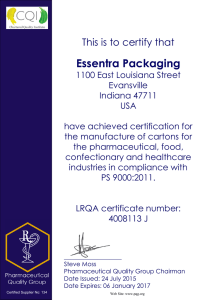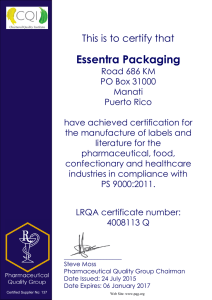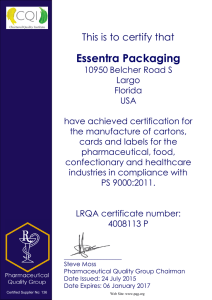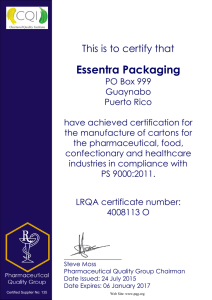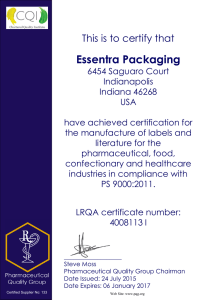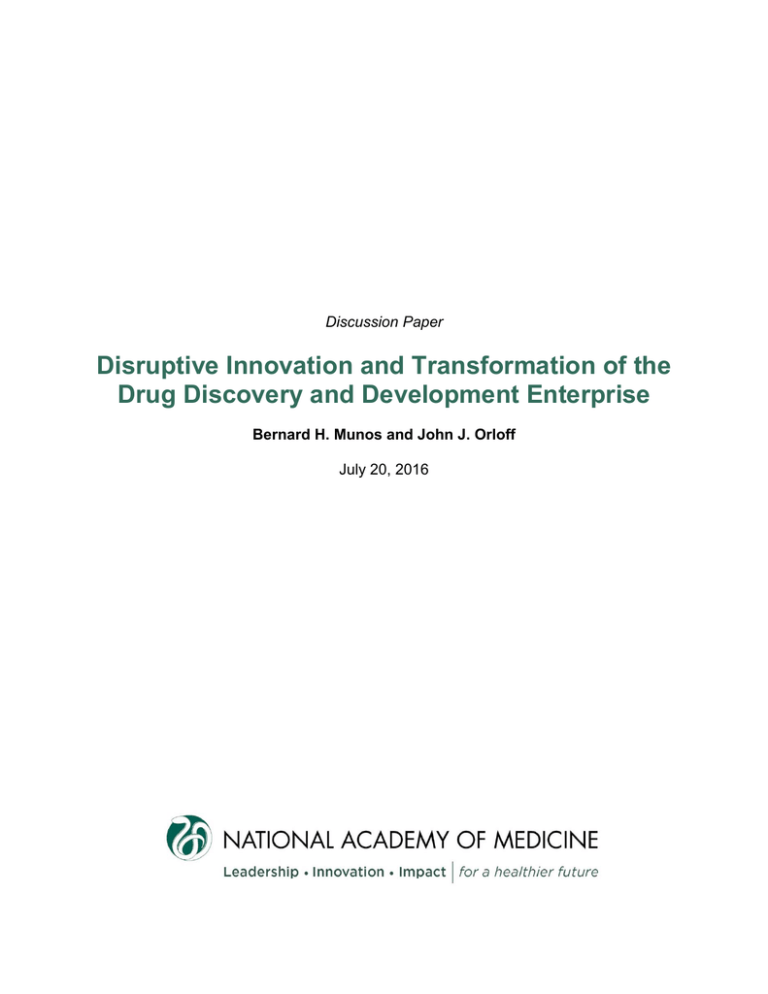
Discussion Paper
Disruptive Innovation and Transformation of the
Drug Discovery and Development Enterprise
Bernard H. Munos and John J. Orloff
July 20, 2016
Disruptive Innovation and Transformation of the Drug
Discovery and Development Enterprise
Bernard H. Munos, M.B.A., M.S., Senior Fellow, FasterCures, and John J. Orloff, M.D.,
most recently Head of Research and Development, Baxalta, Inc.1
PROBLEM STATEMENT
Declining or stagnant research and development (R&D) productivity has led many observers to
argue that the current paradigm for drug discovery and development requires disruptive
innovation2 to break out of a current crisis by identifying and rapidly bringing new discoveries to
market (Bowen and Casadevall, 2015; Elkins et al., 2013; Scannell et al., 2012; Paul et al.,
2010; FitzGerald, 2011; Munos and Chin, 2011). The cost of bringing a new drug to the market
has risen to approximately $2.6 billion over the last decade, up from the previous decade’s
estimate of $1.5 billion (Tufts Center for the Study of Drug Development, 2015), and the overall
likelihood of receiving regulatory approval from Phase I for all drug development candidates is
9.6 percent (Biotechnology Innovation Organization et al., 2016). Despite increased investment,
the number of new therapies and improvements to human health as measured by the growth in
life expectancy have remained relatively constant over the past 50 to 60 years (Bowen and
Casadevall, 2015; Scannell et al., 2012). Sustained competition from generic manufacturers and
overall negative public reactions to costly prescription drugs only add to the complex challenges
facing large pharmaceutical companies (“industry”) today (Hartung et al., 2015; Howard et al.,
2015).
Critics cite the need for the industry to produce more and better products and affordably
innovate if it hopes to survive. To further assess the challenges and reveal potential
opportunities, we undertook a qualitative research project to engage thought leaders and key
stakeholders within the biomedical research ecosystem. Through soliciting the diverse
viewpoints of these leaders (see Appendix A for those interviewed), we gained insight into their
unique perspectives on the state of the pharmaceutical and biomedical research industries,
what could or should change, how those changes might occur, and, generally, what the future
might hold.
INTERVIEWS
We collected a variety of views on disrupting the drug development enterprise in order to
ascertain forces that could serve as an impetus for change. Our goal was to bring forth ideas
and themes to help inform leaders of research, funding, and product development organizations
in the government, nonprofit, and industry sectors as they chart their future course through the
drug discovery and development ecosystem.
We had discussions with 25 leaders from a range of positions and viewpoints in the drug
development ecosystem. The interviewees represented various sectors, including industry,
academia, patient organizations, venture capitalists, entrepreneurs, scientific journal editors,
and industry consultants (see Appendix A for a list of interviewees). All quotations in this paper
1
The authors were assisted by Emily R. Busta, M.S., Anne B. Claiborne, J.D., M.P.H., Christopher J. DeFeo, Ph.D.,
and Rebecca A. English, M.P.H., of the National Academies of Sciences, Engineering, and Medicine.
2
The term “disruptive innovation” is defined here as a transformation of the pharmaceutical industry driven by new
technology, new business models, or policy decisions that improve therapy and create value for patients and society
in a way that could not be achieved through other means.
1
are from interviewees. A discussion guide (see Appendix B) provided a consistent structure for
the interviews. Certain themes emerged as focal points of the discussion, which we explored
further with discussants. We also sought feedback from participants in the Forum on Drug
Discovery, Development, and Translation of the National Academies of Sciences, Engineering,
and Medicine.
The interview process generated themes and ideas that covered the mood of the
industry, the sustainability of the current R&D model, pathways for transformation, new research
and development models, and potential future scenarios. The interviews revealed many unique,
and plausible, visions of the future.
STRENGTHS AND WEAKNESSES OF THE CURRENT INDUSTRY MODEL
A synopsis of the strengths and weaknesses of the current pharmaceutical industry model, as
identified by interviewees, is summarized in Table 1.
Observations on Sustainability
Interviewees generally agreed that the industry is facing significant, sustained challenges, but
opinions regarding the breadth and pace of the transformation needed to address those
challenges, and where the drivers for transformation would originate from, varied widely. One
interviewee indicated that “we are not facing the beginning of the end, but we are in a process of
accelerated transition.” Others suggested that the industry will undergo significant changes,
perhaps even complete disruption, in the next decade. Still others believed that the large
pharmaceutical company model has significant staying power because of its size, criticality, and
lack of a large-scale viable alternative.
Several interviewees commented that there is mixed interest in disruptive innovation
across the major pharmaceutical companies, because the traditional business model (i.e.,
developing and patenting a drug and marketing it to patients) still works reasonably well for
many, and it tends to hide mistakes. Some indicated that although it is not unusual in this
industry for large companies to be supplanted by smaller start-ups (as they become big
companies), the important difference is that start-up companies breaking into the top tier could
introduce new business models that might cause large companies to suffer substantial and
enduring market share losses.
During the course of the qualitative research exercise spanning approximately 12
months, there seemed to be a sense of growing optimism about the state of the enterprise,
possibly driven, in part, by positive trends in the number of novel drugs being approved by
FDA—27 novel drugs approved in 2013, 41 in 2014, and 45 in 2015 (FDA, 2014, 2015, 2016).
Evidence already suggests that new understandings of biological pathways are being leveraged
for targeted products reaching the market (e.g., hepatitis C drugs, immuno-oncology products)
and have greater clinical impact on patients’ lives than some of the incremental “me-too”
products from a generation ago. Some interviewees said that it has taken a lot longer than
originally expected, but the innovation we have been hoping for in the discovery and translation
of new molecular targets has finally come. Recent successes have been attributed to a
deepening of the science, greater ability to turn scientific insights into new medicines, and the
evolution of a new investor base that is better at building successful companies.
2
TABLE 1 Strengths and Weaknesses of Current Pharmaceutical Industry Model
Strengths
Weaknesses
Commercialization. The industry is
still a leader and uniquely qualified
to take a product from late
development to regulatory
approval/registration.
Antiquated R&D Business Model. Innovative drugs
might exist, but not all can be developed because the
R&D infrastructure is too costly. The availability of new
technologies and the application of those technologies to
clinical research have not yet bent the cost curve in the
industry setting. The industry business model for clinical
research has not adapted and is incapable of reaping
the financial advantage of a new technology.
Financing. The industry has the
ability to contribute substantially to
innovation by funding academia and
start-ups, as well as through its own
venture funds.
Expensive Failures. The 40 percent failure rate in
Phase 3 clinical trials is unsustainable. While failing is
necessary for an innovative industry, these failures need
to shift to earlier stages of development in order to
reduce the cost of failing.
Resilience. Industry balance sheets
are quite resilient, making it possible
to sweep many failures under the
“cost rug” and have one very
profitable product make up for the
losses.
Scale. Larger companies tend to make large bets on
new technologies and innovations that often do not pay
off. These may result in big write-offs and loss of
productivity. The overall large scale at which some
companies operate (i.e., directly employing thousands of
scientists and so forth) does not lend itself to nimbly
incorporating new tools, and can create unnecessary
bureaucracy. The large scale “limits innovation because
it creates incentives to protect successes to pay off
failures and not to innovate.” Interviewees noted that
industry is “too big to succeed” and that “the business
model can survive, but not at the scale involving tens of
thousands of employees.”
Obedience. Crowdsourcing within a
pharmaceutical company produces
compatible data sets that facilitate
analysis, whereas traditional
crowdsourcing models tend to
produce incompatible data
structures that complicate analysis.
Culture. Interviewees expressed different cultural
challenges facing the industry. Externally, the industry is
not necessarily the partner of choice for innovators in the
field. Within a company, there can be a sense that it is a
challenge to see good, innovative ideas advance, in part
because the tolerance for risk is low. Even when a CEO
has the mandate and vision for change, he or she can
be impeded by others within the company who are more
risk averse. Some industry spin-offs, subsidiaries,
business units, or external networks designed to operate
separately from a company have successfully addressed
culture issues.
The Measurement of Innovation. The industry might
undertake a variety of innovation activities that produce
new information, technology, or opportunities but has
had difficulty grasping the value that these activities
3
create. Some companies might participate in various
innovation activities but lack sufficient knowledge or
vision for exploiting a new technology that might emerge.
Transparency. Sharing information and doing the right
thing for patients remain challenges for industry.
Harnessing the Latest Science. The explosion of
biological knowledge has often not translated into a
better understanding of how drugs work in patients.
Some progress is taking place in academia/biotech, but
pharma is lagging.
Some pharmaceutical companies are beginning to evolve their R&D models.
Partnerships and collaborations are increasing the flow of new compounds and approaches into
pipelines and companies are exhibiting a greater willingness to invest in start-ups and incubator
models with academic institutions. Some industry executives and R&D experts cite improved
productivity (in the form of increasing numbers of novel drug approvals by FDA) as evidence
that the industry model is effectively responding to the challenges. These trends lend support to
the view that a gradual evolution of the current model is already happening and that a
cataclysmic, disruptive change is therefore less likely to occur.
DISCOVERY AND TRANSLATION
Citing declining productivity from drug discovery efforts within industry, some observers argue
that most insights for new drugs have been and will continue to arise from academia. One
interviewee voiced pessimism, however, noting that “wrong incentives exist, such that the net
productivity of a faculty member’s work is not taken into account when NIH [National Institutes
of Health] funding is considered.”
Concern was expressed that the lack of sufficient funding—from the National Institutes
of Health and others—for early stage discovery efforts will negatively affect the pace of bringing
transformative therapies to market. One interviewee commented that “anything that can be done
to get new technologies and innovations out of academia and into start-ups would be great.”
Many interviewees suggested that more open, “precompetitive” research and data sharing could
accelerate the pace of innovation and increase the flow of new molecules into development
pipelines.
Some interviewees also pointed to the interface between industry and academia and the
challenges in improving collaboration and integration across these sectors. The last few years
have witnessed a proliferation of major pharma-academic alliances as many industry partners
seek to grow their pipelines by gaining access to new scientific discoveries in academic or startup labs. Recent models in which industry has partnered with academia or small start-up
companies include the following:
“Pull” models, in which industry serves as the driver to bring new discoveries into its
pipeline, such as Pfizer’s Centers for Therapeutic Innovation, the Novartis-Penn Center
for Advanced Cellular Therapeutics, and others.
“Push” models, in which academia drives the translation of discoveries into clinical
candidates, such as the Tri-Institutional Therapeutics Discovery Institute, which partners
Rockefeller University, Weill Cornell Medical College, Memorial Sloan Kettering Cancer
4
Center, and Takeda Pharmaceutical Company Limited to support the development of
small molecule drugs and antibodies.
Public-private-partnerships, a collaboration model between academia/nongovernmental
organizations and industry that has been successfully used to fill the gaps in
translational science (e.g., Biomarkers Consortium, Alzheimer’s Disease Neuroimaging
Initiative) as well as revive drug innovation for neglected diseases (e.g., TB Alliance,
Medicine for Malaria Venture).
Risk-sharing models (e.g., “built-to-buy” or option deals), in which a large company
provides funding and other resources to a small company with unique technology, along
with an agreement to buy it at predetermined terms at a later date if it has met certain
milestones.
Many interviewees seemed to agree that tremendous potential exists for creating value at the
interface between academia, industry, and start-up companies, which, if properly harnessed,
could generate a stream of new therapies to fuel lackluster pipelines.
CLINICAL DEVELOPMENT
Currently many efforts are under way to address the challenges of the clinical research
enterprise and improve the efficiency of drug development. Many initiatives, such as the Clinical
Trials Transformation Initiative, are already targeting opportunities for innovation and improved
efficiency in the design and execution of clinical trials.
A number of interviewees noted that drug development, rather than discovery, is the
source of greater inefficiency. The industry now has many innovative targets and drug
candidates, but “the development infrastructure and process are getting in the way.” Many
practices are flawed with respect to trial design, procedures, site qualification, recruitment, and
informed consent, areas that offer significant opportunities for improvement. New technologies,
including biosensors, electronic sourcing, risk-based monitoring, and electronic medical record–
based recruitment tools, are already being piloted and implemented, paving the way for a major
transformation of the clinical research enterprise. Combined with changes in the way clinical
research is conducted—such as clinical research networks or Web-based “virtual” trials—these
new technologies can bring about important savings that can change the economics of drug
development.
OBSERVATIONS OF FDA, NIH, AND ACADEMIA
Many interviewees argued that FDA suffers from some of the same cultural issues that the
industry faces. There is progressive thinking at the top, but, further down, managers can be
reluctant to change. Yet, in these interviews, FDA received high marks for working
collaboratively with industry. Still, some interviewees argued that the industry must do more to
change its relationship to regulators. As one individual put it, “There are lots of things industry
does to placate FDA that FDA actually has no interest in.”
Some interviewees believed that increasing competition for a limited pool of NIH funding
has made basic research ultraconservative. There is a large supply of quality, if conservative,
grant applications that tend to exhaust the funding available, with little money left for bold, but
more speculative research. One individual lamented that “basic research is being neglected. It
cannot get published in the top journals or get adequate funding.” Another suggested that “low
success rates with grants are making NIH very conservative.” Grants go in priority to safe
proposals. They are “not funding bold and deep ideas.”
One interviewee asserted that, within academia, most “don’t understand what it takes to
translate great research into a drug.” Academia could place more emphasis on the importance
5
of translational work, opportunities to partner with industry, and educating students about drug
development. Another individual argued that “academia needs to be disrupted as much as
industry. It does not deliver enough value for money.”
VISIONS OF A TRANSFORMED ENTERPRISE
Many different views were expressed during the interviews of what a transformed drug
discovery and development enterprise might look like, although some common themes
emerged. Disparate views were expressed on the need for transformation and its urgency, the
degree to which transformation was already under way, and whether transformation would
come from within or be imposed from the outside.
Many interviewees believed that we cannot transform the enterprise without changing
the cost structure. But the question arose, “Can the industry change its cost structure, or will it
be done by outsiders?” Until recently, the industry has faced limited pressure to change, but as
margins are squeezed, the need for change is becoming more acute. The industry is also
becoming more vulnerable to disruptive change wrought by an outsider operating with a totally
different model.
For instance, one interviewee commented, “At the moment, drug R&D requires scale,
but challengers are showing that it can be done with less scale, and perhaps differently, by
sharing knowledge.” Some scale might still be needed for efficient global R&D, but that
usefulness may be restricted to operational or executional activities. On the other hand, scale
may be counterproductive for innovation. Innovation will be more intense and nimble in the
future, and the large size of pharma will not help. This dichotomy may be leading some big
pharma companies to focus on what is core to their mission—the execution of development
programs—while leaving scientific innovation to academia and small biotech companies.
Vision #1: Industry Shifts Focus to Health Care Delivery
One possible vision that emerged from the interviews describes a shift in the mission and core
purpose of large pharmaceutical companies to adjacent sectors of the health care industry. In
this view, pharmaceutical companies will remain relevant by disrupting health care delivery,
which some view as needing far more disruption than the pharmaceutical industry. The rationale
is that health care is expensive but delivers little value, and pharmaceutical companies are well
positioned to introduce greater efficiencies, eliminate waste, and revolutionize the delivery of
health care. This view takes the concepts of disease management, “patient centricity,” and
“beyond the pill” to new heights, incorporating a commitment to address all aspects of health
care delivery beyond pharmaceuticals. This effort would require a large-scale transformation of
the pharmaceutical industry and an overall commitment that others may view as unlikely.
The pharmaceutical industry does have opportunities in this arena that are perhaps less
grandiose than the vision articulated above. Specifically, pharmaceutical companies could lead
the integration of clinical research with health care delivery, working with providers to embed
continuous learning, including clinical trials, into information technology (IT) systems and
electronic medical records, which thus far have been focused primarily on the delivery of clinical
care. In this way, pharmaceutical companies would be a catalyst for a learning health care
system, wherein care delivery is integrated with knowledge generation, mediated by nextgeneration electronic medical record systems and IT infrastructures.
Pharmaceutical companies could also play a larger role in providing wraparound care
services, moving from medical product improvement to patient care improvement. This effort
could include personalized approaches that improve the patient experience in the use of
pharmaceutical products, facilitate compliance, and individualize the dose/dosing regimen for
6
patients. A scenario in which industry plays a more direct role in health care delivery could
require policy changes.
Vision #2: Technology Revolutionizes Medicine and Biomedical/Clinical Research
An explosion of digital technologies is already changing the way medicine is practiced and
biomedical research is conducted. Mobile technology such as wearable sensors and
telemedicine tools are making it easier to transmit high-quality data from remote sites to more
central locations for data processing, clinical decision making, and clinical research. Telehealth
could successfully move health care out of expensive, traditional medical institutions and usher
in a more decentralized, lower-cost infrastructure approach to clinical drug development (see
also Vision #3). High-technology companies are becoming increasingly engaged in the
biomedical arena, contributing to innovations such as high-resolution imaging, plug-in devices,
lab-on-a-chip, and data integration. An increase in self-diagnosis will likely be one result of new
technologies, which could have broad implications for the delivery of health care, as well as the
business model for pharmaceutical companies. Disruptions of this nature might come first from
outside the United States “because their policies provide a different landscape for technology
innovation.”
According to this vision for transformation, there will be less influence from direct-toconsumer advertising because people will use social media and other avenues to review
symptoms, disease states, and potential treatments. The value proposition of patient groups will
become even more pronounced for pharmaceutical companies as they become more engaged
and lead with a stronger voice. Patients will have increasing control of their data, enabled by
trusted data-collection platforms, such as those offered by high-tech companies (e.g., Apple’s
ResearchKit) that are rapidly moving into the health care space. The increasing connectivity of
digital networks will enable consumers to catalyze change such that “health care will be owned,
operated, and driven by consumers.” Patients will be viewed not just as participants but as
partners in their clinical trials. This more patient-centric view supports the decentralized model
of clinical trials described in Vision #3.
Treatment management will also be revolutionized by biosensors; patients will use this
information to gauge how effective their treatments are, and this feedback will affect whether
they seek to switch to a different therapy or remain on the current one.
These technological advances have the potential to transform discovery research and
encourage non-hypothesis-driven research; transform clinical research by making it easier and
faster to enroll patients; provide the opportunity for real-time monitoring of trials and individual
patients; and revolutionize the practice of medicine by allowing for the collection and integration
of vast amounts of patient data. One interviewee noted, “Data analytics and mathematics
applied to coherent data will be disruptive.” Another noted that the “future value will be found in
reliable networks and predictive models that can match a drug to a particular patient, enabled
through software development.” The huge amount of fine-grained biosensor data, together with
network connectivity and powerful analytics, will provide unprecedented insights into disease
biology, which will in turn foster novel therapeutic approaches. The cost of entry into this market
will be cheaper—because much of the data and software will be free or available at very low
cost—and the cost of failure will be lower.
Of course, a number of issues must be addressed before the full-scale adoption of the
new technologies. The validation and qualification of biosensors and other technologies must be
done in a way that is acceptable to regulators. Data privacy issues must be overcome. The
streaming of massive amounts of data from multiple disparate sources may cause data overload
and challenge our ability to filter out noise. The quality of data from various sources and the way
the data are aggregated are additional challenges that must be addressed.
7
If the challenges of integrating new technologies can be overcome, the IT companies,
such as Apple, IBM, and Samsung, may be better positioned to drive the development of digital
health than the pharmaceutical industry. Will the pharmaceutical industry lose control over the
collection and analysis of data flowing into the cloud? Will pharmaceutical companies become a
less attractive partner for innovators? Unlike the pharmaceutical industry, the IT companies’
culture is nimble and not encumbered by a rigid regulatory mindset. Exploring and connecting
data sets that have never been connected comes naturally to it and may be a great advantage
in the new data-rich environment “Finding the right data at the right moment to develop the best
predictive models will be disruptive.” For example, the Google X health care division has
partnered with Duke and Stanford on a baseline study to capture the fullest picture of what a
healthy human being should be. All these data exist increasingly outside pharmaceutical
companies, potentially putting Google at an advantage over the pharmaceutical industry to
better understand disease pathways and druggable targets.
Vision #3: A Complex Ecosystem Will Emerge Based on a Revitalized Business Model
In this vision, the roles of the various players in the health care ecosystem and the development
of new products will continue to evolve, while the coexistence of diverse business models will
foster competition and improve value. Some observers predict that pharmaceutical companies
will become smaller with a lighter infrastructure. In this view, industry will focus less on
discovery and more on the development of new drugs, relying on small biotech companies and
academia to produce the new molecules they need to fuel their pipelines. Translational research
will have multiple sources of funding, including venture capital, industry, disease foundations,
and so forth, but only NIH will fund basic science. Pharmaceutical companies may drive
changes in health care delivery, such as improving the patient experience and real-world
outcomes as described in Vision #1. Or they might seek innovation in the execution of clinical
research, exploring new models to conduct clinical trials that are more efficient and less costly,
such as the use of distributed research networks linking various alternative clinical settings or
Web-enabled “virtual” trials. Decentralization of clinical trials has the potential to transform the
conduct of clinical trials and dramatically reduce the infrastructure costs associated with drug
development. In this more patient-centric view, the “elimination of central research sites,”
facilitated by digital technologies, “enables patients to become the site of data acquisition.”
Lowering the cost of innovation will have profound implications on the structure of the
industry and the economics of health care. If it becomes cheaper to innovate, more players will
do it, which will increase the supply of new drugs that can be priced more affordably. Scale,
which has historically been an asset, will be less of a success factor. Diversity, rather than
scale, will become the new hallmark of the industry. The large companies that can remake
themselves and adjust to the new environment will continue to thrive, but others may struggle
and fall behind.
Diversity will also be seen in new business and research models that will closely
collaborate with each other. Data sharing and precompetitive cooperation—long viewed with
skepticism by the industry—will be readily embraced. Consortia, public-private partnerships, and
crowdsourcing platforms will expand and become key players in the new innovation ecosystem.
Patients and nonprofits, such as the Bill and Melinda Gates Foundation, will be important
catalysts in the transformation of that ecosystem. Patients, who will increasingly control data
collection, will use that leverage to advance data sharing, transparency, and open science,
while nonprofits, committed to producing affordable innovation, will keep supporting low-cost
innovation models, some of which will eventually become mainstream.
8
Bernard H. Munos, M.B.A, M.S., is a Senior Fellow at FasterCures, a center of the Milken
Institute. John J. Orloff, M.D., is a global R&D/business leader with 20 years of experience in
the bio-pharmaceutical industry at leading organizations.
REFERENCES
Biotechnology Innovation Organization, Biomedtracker, and Amplion, Inc. 2016. Clinical
development success rates, 2006–2015.
http://bit.ly/22o5TGf?_ga=1.226529307.727240812.1464361380 (accessed May 27,
2016).
Bowen, A., and A. Casadevall. 2015. Increasing disparities between resource inputs and
outcomes, as measured by certain health deliverables, in biomedical research.
Proceedings of the National Academy of Sciences USA 112(36):11335–11340.
Elkins, S., C. L. Waller, M. P. Bradley, A. M. Clarke, and A. J. Williams. 2013. Four disruptive
strategies for removing drug discovery bottlenecks. Drug Discovery Today 18(5–6):265–
271.
FitzGerald, G. A. 2011. Re-engineering drug discovery and development. LDI Issue Brief
17(2):1–4.
FDA (Food and Drug Administration). 2014. Novel new drugs 2013 summary.
http://www.fda.gov/downloads/Drugs/DevelopmentApprovalProcess/DrugInnovation/UC
M381803.pdf (accessed May 27, 2016).
FDA. 2015. Novel new drugs 2014 summary.
http://www.fda.gov/downloads/Drugs/DevelopmentApprovalProcess/DrugInnovation/UC
M430299.pdf (accessed May 27, 2016).
FDA. 2016. Novel new drugs 2015 summary.
http://www.fda.gov/downloads/Drugs/DevelopmentApprovalProcess/DrugInnovation/UC
M481709.pdf (accessed May 27, 2016).
Hartung, D. M., D. N. Bourdette, S. M. Ahmed, and R. H. Whitham. 2015. The cost of multiple
sclerosis drugs in the US and the pharmaceutical industry: Too big to fail? Neurology
(84)2185–2192.
Howard, D. H., P. B. Bach, E. R. Berndt, and R. M. Conti. 2015. Pricing in the market for
anticancer drugs. National Bureau of Economic Research Working Paper 20867.
http://www.nber.org/papers/w20867.pdf (accessed July 11, 2016).
Munos, B. H., and W. W. Chin. 2011. How to revive breakthrough innovation in the
pharmaceutical industry. Science Translational Medicine 3(89)89cm16.
Paul, S. M., D. S. Mytelka, C. T. Dunwiddie, C. C. Persinger, B. H. Munos, S. R. Lindborg, and
A. L. Schacht. How to improve R&D productivity: The pharmaceutical industry’s grand
challenge. Nature Reviews Drug Discovery 9(3):203–214.
Scannell, J. W., A. Blanckley, H. Boldon, and B. Worrington. 2012. Diagnosing the decline in
pharmaceutical R&D efficiency. Nature Reviews Drug Discovery 11(3):191–200.
Tufts Center for the Study of Drug Development. 2015. Outlook 2015. Boston: Tufts University.
Suggested Citation
Munos, B. H., and J. J. Orloff. 2016. Disruptive innovation and transformation of the drug
discovery and development enterprise. Discussion Paper, National Academy of
Medicine, Washington, DC. https://nam.edu/wp-content/uploads/2016/07/DisruptiveInnovation-and-Transformation-of-the-Drug-Discovery-and-Development-Enterprise.pdf.
Disclaimer: The views expressed in this Perspective are those of the authors and not
necessarily of the authors’ organizations, the National Academy of Medicine (NAM), or the
9
National Academies of Sciences, Engineering, and Medicine (the Academies). The Perspective
is intended to help inform and stimulate discussion. It has not been subjected to the review
procedures of, nor is it a report of, the NAM or the Academies. Copyright by the National
Academy of Sciences. All rights reserved.
10
APPENDIX A
Interviewees included the following:
Jeff Allen, Executive Director, Friends of Cancer Research
Linda Avey, Cofounder, Curious, Inc., and Cofounder, 23andMe
Alpheus Bingham, Founder and Member, Board of Directors, InnoCentive
Doug Crawford, Associate Director, QB3, California Institute for Science and Innovation
Steven Cummings, Professor of Medicine, Epidemiology and Biostatistics, Emeritus,
University of California, San Francisco
Standish Fleming, Managing Partner, Forward Ventures
Dalvir Gill, CEO, TransCelerate BioPharma Inc.
David Grainger, Venture Partner, Index Ventures
Magali Haas, Founder and CEO, Orion Bionetworks
Amir Kalali, Vice President, Medical and Scientific Services, Global Therapeutic Team
Leader CNS, Quintiles
Peter Kirkpatrick, Chief Editor, Nature Reviews Drug Discovery
Kelly LaMarco, Senior Editor, Science Translational Medicine
Robert Langer, David H. Koch Institute Professor of Chemical and Biomedical
Engineering, Massachusetts Institute of Technology
Craig Lipset, Head of Clinical Innovation, Pfizer
Roger Longman, CEO, Real Endpoints
Derek Lowe, Heavy Duty Industrial Scientist, Vertex
Tom Main, Partner, Founder of the Oliver Wyman Health Innovation Center
Kal Patel, Chief Commercial Officer, Doctor on Demand (Global Marketing Lead—
Enbrel, Amgen, at the time of the interview)
Arti Rai, Elvin R. Latty Professor of Law, Duke University
Mike Rea, Partner and CEO, IDEA Pharma
David Shaywitz, Chief Medical Officer, DNAnexus (Senior Director, Strategic and
Commercial Planning, Theravance, at the time of the interview)
Melissa Stevens, Executive Director, Center for Strategic Philanthropy, Milken Institute
(Deputy Executive Director, FasterCures, at the time of the interview)
Marc Tessier-Lavigne, President, Rockefeller University
Eric Topol, Director, Scripps Translational Science Institute
John Wilbanks, Chief Commons Officer, Sage Bionetworks; Senior Fellow, FasterCures
11
APPENDIX B
Discussion Guide
This discussion guide has been designed to engage respondents and seek their opinions and
ideas on topics that are likely to influence change in the pharmaceutical industry over the next
decade. It opens the discussion with questions about the sustainability of the industry model
and follows with questions on the three drivers that are likely to reshape the industry, i.e., new
technologies, new business models, and policy decisions. Respondents are expected to vary in
their opinions on the status of the industry and the need, speed, and breadth of the change that
is likely to occur. There is no right or wrong answer. The goal of these interviews is simply to
identify the factors that are likely to play a role in the industry's future.
For purposes of this discussion, “disruptive innovation” is defined as a transformation of the
pharmaceutical industry driven by new technology, new business models, or policy decisions
that improve therapy and create value for patients and society in a way that could not be
achieved through other means. While a discussion of the theory of disruptive innovation is
worthwhile in a number of venues, this conversation is meant to focus on the unique challenges
and opportunities for the pharmaceutical industry to harness innovative forces, those forces that
are emerging as well as those that are still unknown, for societal benefit. We are particularly
interested in learning about the potential for truly dynamic and disruptive innovation (as opposed
to marginal innovations that modify the ecosystem only slightly).
Attitude vis-à-vis Sustainability
Some commentators have argued that the pharmaceutical industry faces a triple challenge: it
must produce more, better, and affordable innovation. Can it successfully address those three
challenges, or are we trying to square the circle? (If it cannot address all three challenges, what
are the ones that cannot be tackled?)
In 2013, on average big pharma spent $5.4 billion in R&D. Since 2000, new molecular entity
(NME) production for big pharma has been flat and has averaged 0.85 NME per company and
per year. Seventy percent of these drugs end up not being blockbusters and peak at about $400
million. Is this sustainable? Does R&D create or destroy value?
Several big pharma CEOs, such as Messrs. Witty and Viehbacher, have gone on record
claiming that big pharma's return on R&D is negative, perhaps losing as much as $0.30 for each
dollar spent on research. Is their math right?
Big pharma companies collect on average 50 percent of their sales from products that have
been in the market for 12 years or more and are—or are about to become—generic. Managing
these products and keeping them going consumes a significant amount of executive attention.
Can companies truly innovate and reinvent the future when so much of management's attention
is focused on the past?
New Technologies
A growing number of new therapies in development do not involve drugs—things such as cell
therapy, gene therapy, gene editing, immune therapies, apps that retrain the brain,
nanomedicine, etc. Yet, with some exceptions, large companies are not prominent in these
12
fields. Why is that? Is there a risk that existing companies may fall behind in their ability to
translate these new biomedical discoveries?
The great translational successes of the past—insulin, antibiotics, rDNA, monoclonal antibodies,
etc.—were achieved by companies that seized upon immature technologies and turned them
into new therapies. Today, companies—including some of the same—seem less prone to do
that. Why this reluctance? Can this be somehow linked to the innovation challenges
experienced by the industry?
New data capture technologies such as biosensors and plug-in devices promise to give us more
health data than we ever had. This could impact the way we do research. What do you think this
impact might be? Are pharmaceutical companies prepared to deal with a future in which a lot of
the data may not come from randomized controlled trials and will be collected, stored and
owned by someone else?
New Business Models
New business models such as precompetitive research, crowdsourcing, networked innovation,
virtual companies, drug repurposing, and forced disruption (e.g., DARPA) are spreading and
enriching the biomedical innovation ecosystem. The pharmaceutical industry has not always
been quick to embrace them. Is this changing? Can the pharmaceutical industry leverage some
of these models to become better innovators? Are these models synergistic or antagonistic with
the current pharma model? How will they impact the economics of drug R&D, as well as its size
and profitability?
Policy Changes
Payers around the world have become increasingly assertive in challenging intellectual property
(IP) or capping drug prices. Will this ease or worsen in the future? How to best deal with these
threats?
What might happen if the US government were to become involved in drug price negotiations?
How realistic is this prospect?
13

